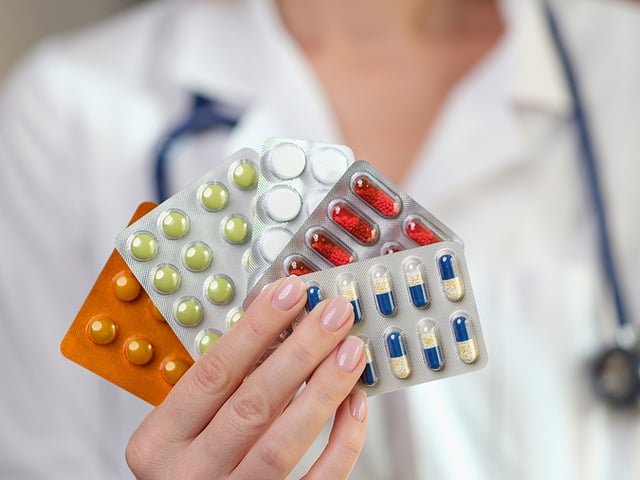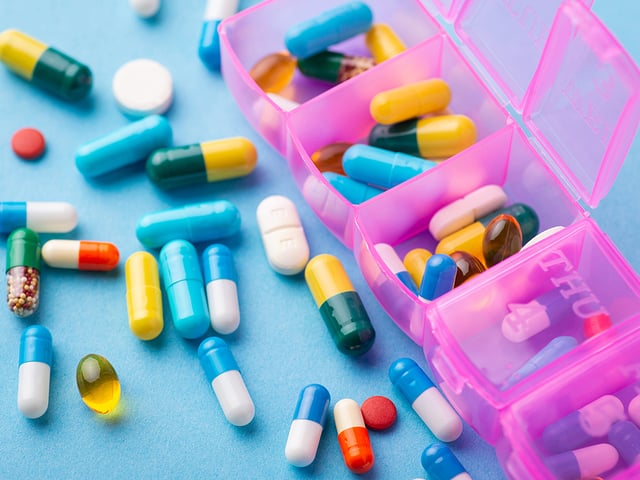
Calculating Medicine Doses
Performing pharmacy calculations is an essential function of a pharmacy technician, regardless of the practice setting. The pharmacy technician must be fluent and comfortable calculating the dosing of a medication, as this is a large portion of the calculations being performed.
Calculation Types
Calculating a medication’s dose can be complex, as when preparing to make an IV bag with multiple ingredients, or simple, as when performing data entry of a prescription for a solution or suspension. Being able to perform basic arithmetic in addition to knowing measurement conversion factors will make pharmacy calculations a piece of cake. And who doesn’t like cake?
Practice Makes Perfect
Here are a few examples of some real-world pharmacy calculations that focus on figuring out a medication’s dose.
Example 1
Lorazepam Intensol \(2\) mg/mL
\(0.5\) mg PO/SL q\(4\)hr PRN
Disp: \(30\) mL \(0\) Refills
How many mL should the patient take according to this prescription?
\[0.5 \text{ mg} \times \dfrac{1\text{ mL}}{2 \text{ mg}}=0.25 \text{ mL}\]To double check yourself, reduce the fraction,\(\dfrac{0.5\text{ mg}}{0.25\text{ mL}}\)
which does reduce down to \(2\) mg/mL.
Example 2
Amoxicillin Suspension \(250\) mg/\(5\) mL
\(17.5\) mL by mouth twice daily until gone
Disp: QS to closest available package size \(0\) Refills
What is the dosage the patient should be taking in mg?
\(250\) mg/\(5\) mL reduces down to \(50\) mg/mL.
\(17.5 \text{ mL} \times \dfrac{50 \text{ mg}}{\text{ mL}} = 875 \text{ mg }\) per dose
Example 3
Vancomycin IV Bag
A hospitalist writes an order for Vancomycin.
The provider wants the patient to receive an initial dose of \(15\) mg per kg in the emergency room.
The patient weighs \(160\) lbs.
What is the dose in mg?
\(1\) kg = \(2.2\) lb, so \(160 \text{ lb} \times \dfrac{1 \text{ kg}}{2.2 \text{ lb}}=75\text{ kg}\)
\[75 \text{ kg} \times 15\dfrac{\text{ mg}}{ \text{ kg}} = 1,125 \text{ mg}\]The hospital has Vancomycin \(500\) mg powder vials on formulary that must be reconstituted with \(10\) mL of sterile water. Given the dose calculated above, how many mL will be added to an IV bag of \(0.9\)% normal saline (NaCl)?
\(500\) mg/\(10\) mL reduces to \(50\) mg/ mL, so \(1,125 \text{ mg} \times \dfrac{1 \text{ mL }}{50 \text{ mg}} = 22.5 \text{ mL}\)
Example 4
Enoxaparin Injection
A prescriber writes a prescription for Enoxaparin Inj \(1\) mg per kg SC q\(12\) hr for \(7\) days. The patient weighs \(176\) lb.
What is the patient’s dose in mg?
\[176 \text{ lb} \times \dfrac{1 \text{ kg}}{2.2 \text{ lb}}=80\text{ kg}\] \[80 \text{ kg} \times \dfrac{1\text{ mg}}{ \text{ kg}} = 80\text{ mg}\]Enoxaparin is commercially available in prefilled syringes. For this patient, the technician would select the \(80\) mg/\(0.8\) mL syringes for the pharmacist to verify prior to dispensing.
Ensuring Dose Accuracy
Calculating a medication’s dosage must be done with a minimal margin of error. To ensure patient safety, both pharmacy technicians and pharmacists must stay vigilant when performing such calculations.
-
It is important to double check and sometimes even triple check your work to ensure accuracy.
-
If a dosage does not make sense, be sure to check with your pharmacist and even the physician, if the pharmacist deems it necessary.
-
Remember to reduce down concentrations (mg/mL) to make calculations easier and always keep track of the units.
Checking Prescriptions for Errors
Another crucial part of pharmacy calculations is error checking. This goes hand-in-hand with the above-mentioned accuracy in dosing. Not only should the calculations be accurate, but the prescription itself should also be scrutinized for possible errors.
-
Look out for any illogical or dangerous dosage recommendations.
-
Check for possible drug interactions if the patient is on multiple medications.
-
Allergies can also come into play. Make sure to ask the patient or check their medical record for any known allergies to medications.
Example 5
Hydrocodone/Acetaminophen (Norco) 5 mg/325 mg.
Take 6 tablets by mouth every 4 hours.
Disp: 120 tablets. 0 Refills.
While this prescription might seem straightforward, a quick calculation shows that the patient would be taking 30 tablets or 9750 mg of acetaminophen in a 24-hour period, which is well above the maximum recommended daily dosage of 4000 mg. This could potentially lead to liver damage. In this case, it’s crucial to contact the prescriber to clarify and modify the prescription.
Whew, so who is ready for that piece of cake? If you found yourself struggling with some of the math, check out our math basics study material for a review of multiplication using fractions and measurement conversions. If you’re ready to test you knowledge, try our PTCB practice tests and flashcards.
Keep Reading

PTCB Pharmacy Technician Certification Exam Blog
Memorable Mnemonics: Master Drug Knowledge for the PTCB Exam
Studying for the Pharmacy Technician Certification Board (PTCB) exam is…

PTCB Pharmacy Technician Certification Exam Blog
The Top 200 Drugs on the PTCB
The Pharmacy Technician Certification Board (PTCB) exam is the final st…

PTCB Pharmacy Technician Certification Exam Blog
Is the PTCB Exam Hard?
Is the PTCB Exam Hard? Did you know that in 2021, over 430,000 pharmac…